Electric scooters are eco-friendly, convenient, and popular personal transport solutions. Understanding their mechanics, benefits, and maintenance ensures optimal performance and longevity. This manual provides essential insights for repair, safety, and troubleshooting.
1.1 Understanding the Basics of Electric Scooters
An electric scooter is a lightweight, eco-friendly vehicle powered by an electric motor and battery. Key components include the motor, battery, controller, and braking system. Most scooters feature portable designs, making them ideal for short-distance commuting. Understanding these basics is crucial for maintenance and repair. Familiarize yourself with the scooter’s power output, battery capacity, and braking mechanisms to ensure safe and efficient operation. This foundation is essential for troubleshooting and performing repairs effectively.
1.2 Benefits of Owning an Electric Scooter
Owning an electric scooter offers numerous advantages, including reduced environmental impact, lower operating costs, and increased mobility. They are eco-friendly, producing zero emissions, and provide a cost-effective alternative to traditional vehicles. Electric scooters are ideal for short-distance commuting, eliminating traffic hassles and parking challenges. Additionally, they promote physical activity for those who prefer kick-start models. Their portability and ease of use make them a practical choice for urban environments. Overall, electric scooters are a sustainable, efficient, and convenient transportation solution for modern commuters.
1.3 Popular Electric Scooter Brands and Models
Several brands stand out in the electric scooter market, offering high-quality and reliable models. Razor is renowned for its E90, E300, and Power Core series, known for durability and performance. Segway’s ES series, including the ES2 and ES4, offers advanced features like high-speed modes. Xiaomi’s Mi M365 is celebrated for its long battery life and sleek design. Bird and Lime, popular in scooter-sharing services, also produce durable models for personal use. These brands consistently deliver innovative designs, making them favorites among commuters and enthusiasts alike.

Essential Tools for Electric Scooter Repair
Key tools include screwdrivers, wrenches, pliers, multimeters, and tire pressure gauges. A circuit tester and torque wrench are also crucial for advanced diagnostics and repairs.
2.1 Must-Have Tools for DIY Electric Scooter Maintenance
A essential toolkit for DIY electric scooter maintenance includes screwdrivers, pliers, wrenches, and a multimeter for diagnosing electrical issues. A torque wrench ensures proper bolt tightening, while a tire pressure gauge helps maintain correct tire inflation. Additionally, a circuit tester and wire cutters are useful for repairing or replacing electrical components. These tools empower owners to perform routine checks, repairs, and upgrades, ensuring safety and optimal scooter performance. Always refer to your specific scooter’s manual for tool recommendations tailored to your model.
2.2 Importance of Using the Right Tools
Using the right tools for electric scooter maintenance is crucial for safety, effectiveness, and preventing damage. Incorrect tools can strip screws, damage components, or lead to improper repairs, potentially causing safety hazards. Proper tools ensure precise adjustments and prevent electrical or mechanical failures. They also save time and effort, making repairs more efficient. Always refer to your scooter’s manual for recommended tools to avoid complications and ensure reliability. Using the right tools safeguards both the scooter and the rider, promoting optimal performance and longevity.
2.3 Recommended Brands for Electric Scooter Repair Tools
For reliable electric scooter repair, consider tools from trusted brands like Inmotion, known for high-quality repair kits, or TorqueTools, offering precise screwdrivers and wrenches. ElectricScooterParts.com is another excellent resource, providing a wide range of specialized tools. These brands ensure compatibility and durability, essential for safe and effective repairs. Always verify tool compatibility with your scooter model, as specified in your repair manual, to avoid damage or safety risks.

Safety Precautions and Best Practices
Always follow safety guidelines when repairing electric scooters. Use genuine parts, avoid wet conditions, and adhere to manual instructions for safe and effective repairs.
3.1 General Safety Guidelines for Electric Scooter Repair
Before starting any repair, always disconnect the battery to prevent electric shocks. Wear protective gear, including gloves and safety glasses. Ensure the scooter is on a stable, flat surface. Avoid working in wet conditions or near open flames. Use only approved tools and genuine parts to maintain safety and functionality. Refer to the repair manual for specific precautions and follow all manufacturer instructions carefully. Regularly inspect the scooter for loose components and damage to ensure safe operation after repairs. By adhering to these guidelines, you can minimize risks and achieve successful outcomes.
3.2 Protective Gear and Workspace Setup
Wear essential protective gear, including gloves, safety glasses, and a face mask, to safeguard against injuries and dust. Ensure your workspace is clean, well-lit, and free from hazards. Place the scooter on a stable, flat surface, such as a workbench, to prevent accidents. Organize tools and parts systematically to avoid misplacement. Keep a fire extinguisher nearby and ensure good ventilation, especially when handling batteries or chemicals. A clutter-free and well-prepared workspace enhances safety and efficiency during repairs.
3.4 Best Practices for Handling Electrical Components
Always disconnect the battery before working on electrical components to prevent shocks or short circuits. Use insulated tools to protect components from static discharge. Avoid touching sensitive electronics with bare hands. Refer to your scooter’s manual for specific electrical diagrams and instructions. Never modify the electrical system unless you are experienced. Store components in a dry, static-free environment. Test all connections and components before reassembling the scooter to ensure proper function. Follow these practices to maintain safety and preserve the integrity of your electric scooter’s electrical system.

Diagnosing Common Issues
Identifying common issues such as battery problems, motor malfunctions, and brake faults is crucial for effective electric scooter repair. This section guides you through diagnostic steps for optimal repair.
4.1 Identifying Battery-Related Problems
Battery issues are common in electric scooters, often causing power loss or startup failures. Check voltage levels using a multimeter to ensure they match specifications. Look for swelling, corrosion, or leaking, which indicate faulty cells. Verify connections are secure and free from damage. Test the charger to rule out charging system faults. If the battery doesn’t hold charge, it may need replacement. Always refer to your scooter’s manual for specific diagnostic steps and safety precautions to avoid further damage or hazards.
4.2 Troubleshooting Motor and Controller Issues
Motor and controller problems can cause reduced performance or complete shutdown. Check for unusual noises, vibrations, or error codes on the display. Test motor resistance using a multimeter to detect short circuits or open phases. Verify controller connections to ensure proper communication with the motor. Inspect for overheating, which may indicate faulty components. Consult the repair manual for specific diagnostic codes and procedures. If issues persist, professional assistance may be required to repair or replace damaged parts. Always use appropriate tools and follow safety guidelines to avoid further damage or injury.
4.3 Diagnosing Brake System Malfunctions
Brake system issues can compromise safety, so prompt diagnosis is crucial. Start by inspecting brake pads for wear and ensuring proper alignment. Check the brake lever for sponginess, which may indicate air in the system or worn pads. Test the brake caliper for responsiveness and ensure it moves freely. Examine cables and connections for damage or corrosion. Use a multimeter to verify electrical continuity in e-brake systems. Clean or replace components as needed, and refer to the repair manual for torque specifications. Always test brakes thoroughly after repairs to ensure reliability and safety.
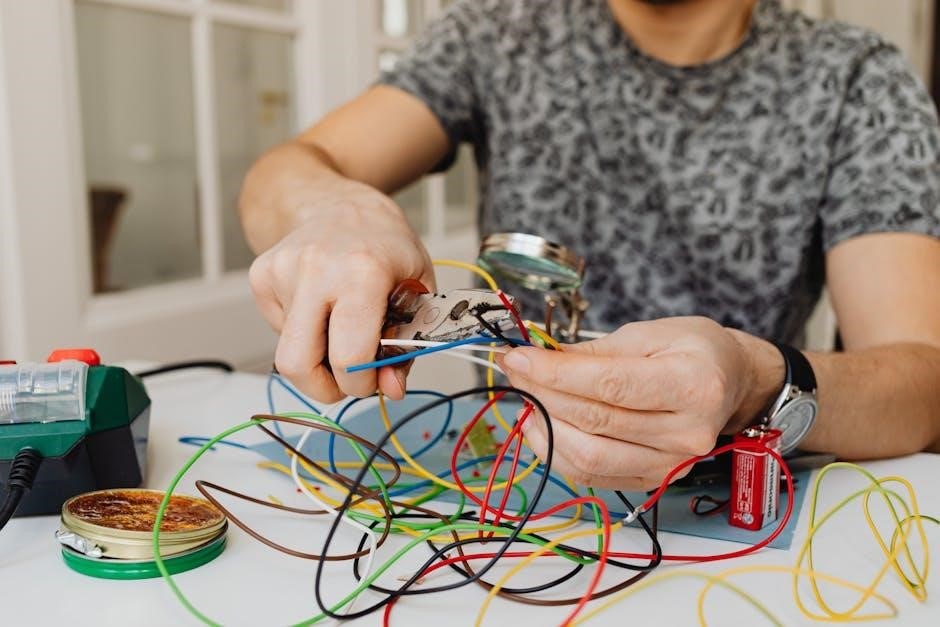
Maintenance and Repair Tips
Regularly inspect batteries, brakes, and tires. Lubricate moving parts and tighten loose connections. Refer to your manual for specific maintenance schedules and repair guidelines to ensure safety and performance.
5.1 Routine Maintenance Tasks
Regular maintenance is crucial for extending the life of your electric scooter. Start by inspecting the tires for proper inflation and signs of wear. Clean the scooter thoroughly, paying attention to electrical components to prevent corrosion. Check the brakes for functionality and adjust them if necessary. Lubricate moving parts like the folding mechanism and suspension. Ensure the battery is charged correctly and stored in a cool, dry place. Follow the manufacturer’s guidelines for routine checks to maintain optimal performance and safety.
5.2 Replacing Worn or Damaged Parts
Replacing worn or damaged parts is essential for maintaining your electric scooter’s performance and safety. Start by identifying the faulty component, such as tires, brakes, or batteries. Always use genuine or compatible replacement parts to ensure proper function. Disconnect the battery before beginning any repair to avoid electrical hazards. Follow the manual’s instructions for disassembly and reassembly. Tighten all fasteners securely and test the scooter to ensure everything works smoothly. Regularly replacing worn parts prevents further damage and keeps your scooter running efficiently.
5.3 Upgrading Electric Scooter Components
Upgrading your electric scooter’s components can enhance performance, speed, and durability. Consider upgrading the battery for longer range, the motor for more power, or tires for better traction. Ensure compatibility with your scooter’s existing systems to avoid malfunctions. Use genuine or high-quality aftermarket parts for reliability. Always consult the manual for specific upgrade instructions and safety precautions. Testing the scooter after upgrades is crucial to ensure everything functions correctly. Upgrades can personalize your ride and improve overall satisfaction, making it a worthwhile investment for enthusiasts and regular users alike.
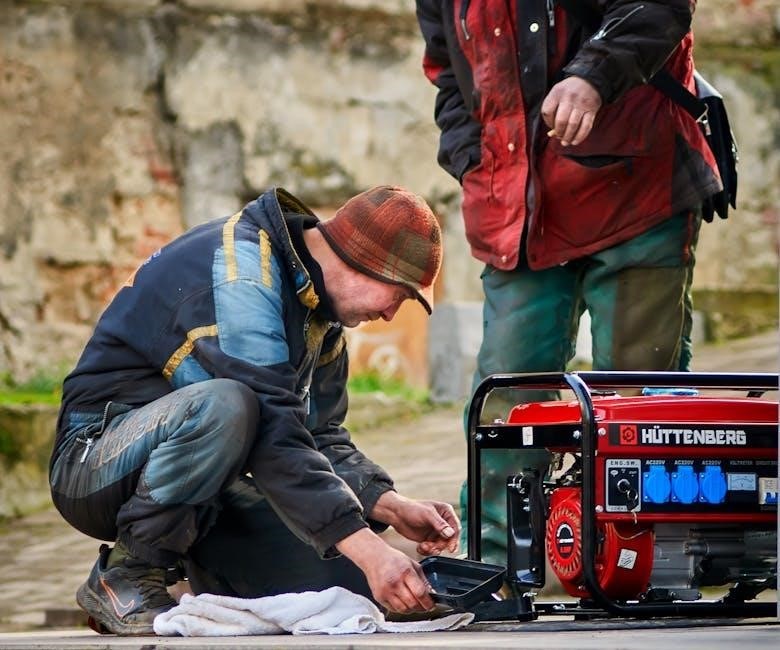
Electric Scooter Repair Manual Overview
A comprehensive guide detailing repair procedures, troubleshooting, and maintenance for electric scooters. Includes safety tips, diagnostic steps, and detailed instructions for common fixes and upgrades to ensure optimal functionality.
6.1 What to Expect in a Comprehensive Repair Manual
A detailed repair manual offers step-by-step guides, troubleshooting tips, and diagrams for diagnosing issues. It covers essential topics like battery maintenance, motor repair, and brake system fixes. Expect clear instructions for common problems, safety precautions, and tools needed. The manual also provides maintenance schedules and tips for extending scooter lifespan. Whether you’re a novice or experienced technician, it serves as a valuable resource for understanding and resolving electrical, mechanical, and software-related issues effectively.
6.2 How to Use the Manual Effectively
Start by reading the safety guidelines and familiarizing yourself with the manual’s structure. Use the index or table of contents to quickly locate specific topics. Follow step-by-step instructions carefully, and refer to diagrams for visual clarity. Always prioritize safety when working with electrical components. If unsure, consult the troubleshooting section or seek professional assistance. Regularly update your knowledge with the latest repair techniques and guidelines provided in the manual to ensure efficient and safe repairs.
6.3 Key Sections Every Manual Should Cover
A comprehensive repair manual should include detailed sections on safety precautions, troubleshooting common issues, and step-by-step repair guides. It should also cover parts identification, torque specifications, and electrical system diagrams. Additionally, maintenance schedules, battery care, and upgrade options are essential. Clear instructions for disassembling and reassembling components, along with error codes and diagnostic tools, ensure users can address problems confidently. High-quality images and diagrams further enhance understanding, making the manual a invaluable resource for both beginners and experienced repairers.
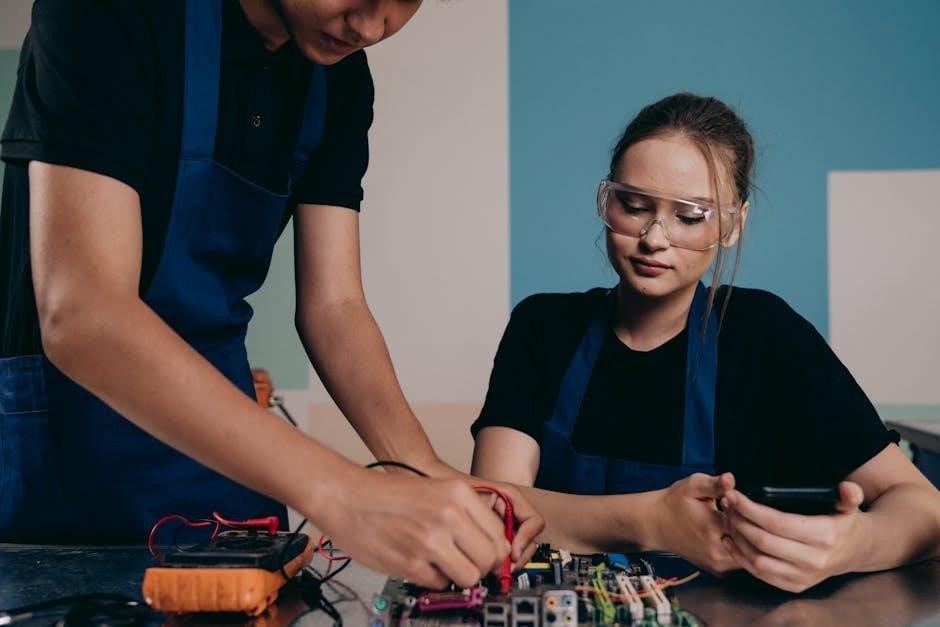
Frequently Asked Questions (FAQs)
Common questions include troubleshooting battery issues, repairing brakes, and maintaining motor efficiency. This section provides clear answers and solutions, ensuring riders can resolve problems effectively and safely.
7.1 Common Questions About Electric Scooter Repair
Common questions include how to diagnose battery issues, repair faulty brakes, and maintain motor efficiency. Riders often inquire about essential tools, DIY maintenance tips, and troubleshooting common faults. Many ask about safety practices, such as handling electrical components and ensuring proper scooter assembly. Additionally, users seek advice on upgrading parts, understanding error codes, and finding reliable repair manuals. These questions highlight the importance of a comprehensive guide to address both basic and advanced repair needs effectively.
7.2 Solutions to Frequently Encountered Problems
Common issues like a non-turning motor or faulty brakes can often be resolved by checking connections, cleaning components, or replacing worn parts. For battery-related problems, ensure proper charging and avoid over-discharging. Brake malfunctions may require adjusting or replacing brake pads. DIY fixes, such as tightening loose screws or resetting the circuit, are often effective. Always refer to your manual for specific instructions. If issues persist, consulting a professional or using online troubleshooting guides can provide tailored solutions.
7.3 Tips for First-Time Repairers
For first-time repairers, start by thoroughly reading the manual to understand your scooter’s components. Always wear protective gear and work in a well-lit, ventilated area. Begin with simple tasks like cleaning or tightening loose parts before tackling complex repairs. Use the right tools to avoid damaging components. If unsure, consult online guides or forums for step-by-step instructions. Practice patience and take breaks to avoid frustration. Reassemble carefully to ensure all parts are secure. Remember, it’s okay to seek professional help if a problem seems too challenging. Start small and learn as you go!
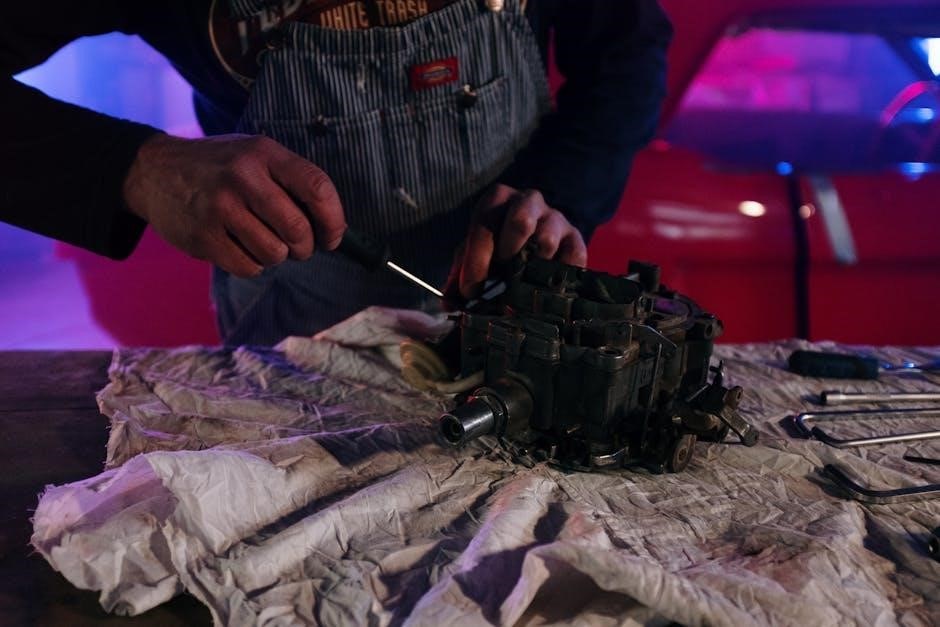
Troubleshooting Guides
Troubleshooting guides provide step-by-step solutions for common electric scooter issues. Check power sources, ensure proper assembly, and inspect for error indicators. Diagnostic tools and manuals are essential.
8.1 Step-by-Step Guides for Specific Issues
Step-by-step guides are essential for diagnosing and resolving specific electric scooter issues. Start by identifying symptoms, such as power loss or faulty brakes. Check the power switch, fuse, and battery connections. For motor issues, inspect wires and connectors for damage. Brake problems may require adjusting or replacing worn pads. Use diagnostic tools to identify error codes and refer to the manual for solutions. Always prioritize safety and follow proper repair procedures to ensure your scooter operates efficiently and safely. Regular maintenance can prevent many common issues.
8.2 How to Identify and Fix Common Faults
Identifying and fixing common faults in electric scooters requires a systematic approach. Start by observing symptoms like reduced speed or erratic behavior. Check the power switch, fuse, and battery connections for issues. Use a multimeter to test battery voltage and diagnose electrical faults. For motor problems, inspect wires and connectors for damage. Brake issues often involve worn pads or misalignment. Refer to the repair manual for specific troubleshooting steps. Always disconnect the battery before making repairs. Addressing faults early prevents major damage and ensures safe, reliable operation. Regular checks can help identify potential issues before they escalate.
8.3 Advanced Troubleshooting Techniques
Advanced troubleshooting involves diagnosing complex faults like motor controller issues or battery management system errors. Use specialized tools such as multimeters and oscilloscopes to analyze electrical signals. Check for firmware updates or corrupted software causing malfunctions. Inspect wiring harnesses for hidden damage and ensure proper connections. For persistent issues, consult detailed repair manuals or seek professional assistance. Advanced techniques require a deep understanding of electrical systems and mechanical components, ensuring accurate diagnoses and effective repairs. Always prioritize safety when handling high-voltage systems and complex scooter mechanics.

Legal and Regulatory Considerations
Electric scooter repair must comply with local laws and safety standards to ensure legality and safety. Proper disposal of parts reduces environmental impact and promotes sustainability.
9.1 Understanding Local Laws and Regulations
Local laws and regulations govern the use and repair of electric scooters, ensuring compliance with safety and environmental standards. Registration, insurance, and operational guidelines vary by region. Repair technicians must adhere to these rules to avoid legal issues. Additionally, environmental regulations may dictate proper disposal methods for batteries and parts. Staying informed about local ordinances is crucial for both riders and repair professionals. Always consult local authorities or official resources for the most accurate and up-to-date information before performing any repair work.
9.2 Importance of Adhering to Safety Standards
Adhering to safety standards is critical when repairing electric scooters to prevent accidents and ensure reliability. Proper tools, protective gear, and adherence to manufacturer guidelines are essential. Ignoring safety protocols can lead to electrical hazards, mechanical failures, or legal consequences. Compliance with standards ensures the scooter operates safely and efficiently. Always follow recommended practices for handling batteries, electrical components, and mechanical systems. This not only protects the technician but also guarantees the scooter’s performance and longevity for the user. Safety standards are non-negotiable in any repair process.
9.3 Environmental Impact of Electric Scooter Repair
Electric scooter repair plays a significant role in reducing environmental impact by promoting sustainability. Proper repair extends the scooter’s lifespan, reducing the need for new resources and minimizing waste. Recycling and responsible disposal of batteries, motors, and other components prevent hazardous materials from entering landfills. Additionally, repairing rather than replacing reduces the carbon footprint associated with manufacturing and transportation. Adhering to eco-friendly repair practices supports a greener approach to personal mobility and contributes to a more sustainable future.
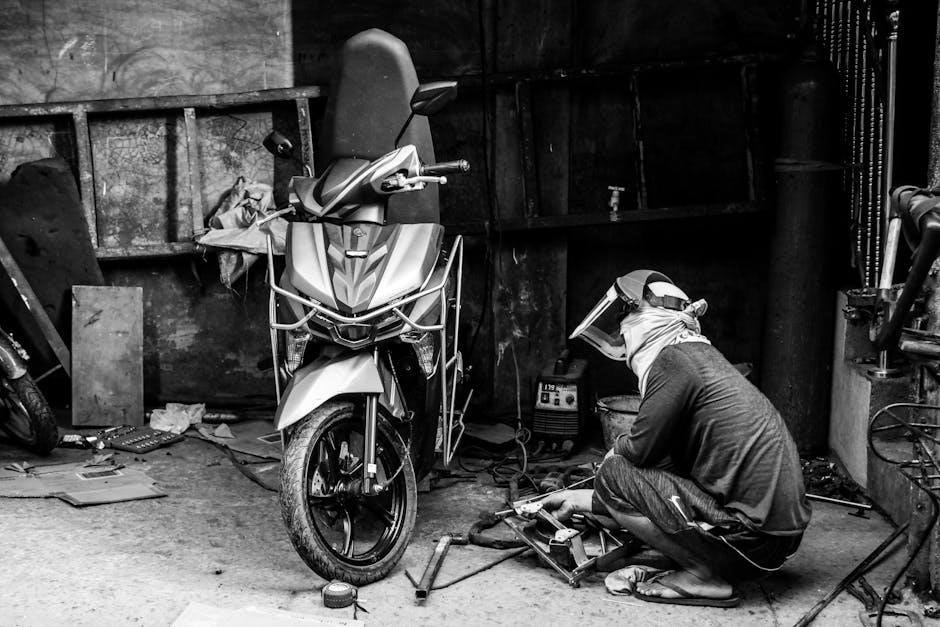
Resources for Further Learning
Explore recommended websites, forums, and eBooks for in-depth guides, troubleshooting tips, and expert advice on electric scooter repair and maintenance.
10.1 Recommended Websites and Forums
For comprehensive guides and expert advice, visit ElectricScooterParts.com for repair tips and manuals. Forums like ElectricScooterForum.net offer community support and troubleshooting discussions. Additionally, ScooterRepairGuide.com provides detailed tutorials and downloadable resources. These platforms are invaluable for DIY enthusiasts and professionals alike, ensuring access to reliable information and solutions.
10.2 Suggested Books and eBooks
For in-depth knowledge, consider “Electric Scooter Repair Guide” by John Smith, offering detailed DIY solutions. “Scooter Maintenance Mastery” by Jane Doe provides practical tips for extending scooter life. Additionally, “Electric Scooter Troubleshooting” by Alex Johnson covers common issues and fixes. These resources, available on platforms like Amazon Kindle and Google Books, are essential for enthusiasts seeking hands-on expertise and comprehensive understanding of electric scooter mechanics.
10.3 Online Communities for Electric Scooter Enthusiasts
Joining online forums like Electric Scooter Parts or ScooterForums.net connects you with a vibrant community of enthusiasts. These platforms offer repair guides, DIY tips, and troubleshooting advice. Facebook groups like “Electric Scooter Repair” and Reddit’s r/ElectricScooters are excellent for sharing experiences and learning from experts. Engaging with these communities provides valuable insights, helping you maintain and enhance your scooter effectively. They also serve as great resources for finding rare parts and staying updated on the latest trends in electric scooter maintenance and customization.
Electric scooter repair empowers users to extend their vehicle’s lifespan through DIY maintenance and troubleshooting. With the right tools and knowledge, enthusiasts can ensure safety, performance, and longevity.
11.1 Final Thoughts on Electric Scooter Repair
Electric scooter repair is a rewarding process that empowers users to extend the life of their vehicles. By following proper safety protocols and using the right tools, enthusiasts can confidently diagnose and fix common issues. Regular maintenance and adherence to manufacturer guidelines are key to ensuring optimal performance and longevity. Remember, continuous learning and staying updated on best practices will enhance your troubleshooting skills. Always refer to your specific repair manual for detailed instructions tailored to your scooter model.
11.2 Encouragement for DIY Enthusiasts
DIY enthusiasts, embrace the challenge of electric scooter repair! With patience and the right resources, you can master the skills needed to maintain and improve your scooter. Start with small repairs and gradually tackle more complex tasks. Remember, every fix is a learning opportunity. Use repair manuals and online forums to guide you. Don’t hesitate to seek advice from communities or professionals when needed. Your dedication will save money and deepen your connection with your scooter. Keep experimenting, learning, and enjoying the journey of hands-on problem-solving.
11.3 Importance of Continuous Learning
Continuous learning is vital for mastering electric scooter repair. As technology evolves, staying updated with new techniques and tools ensures you remain proficient. Regularly review repair manuals, troubleshooting guides, and online forums to expand your knowledge. Engaging with communities and experts fosters growth and problem-solving skills. Dedicate time to understanding emerging trends and best practices, ensuring you’re equipped to handle any challenge. Embrace lifelong learning to enhance your repair skills and maintain your scooter’s optimal performance.